Is 95 Amp Mig Welder Ok for Metal Art
0
What's the Best Gas to Employ for MIG Welding?
Final Updated on
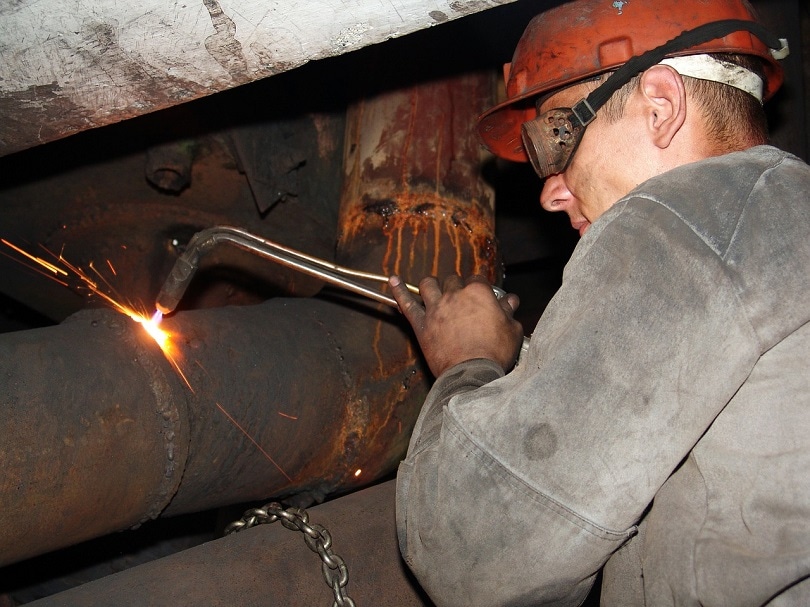
Credit: stafichukanatoly, Pixabay
MIG welding utilizes a hand-held gun with a spool-fed cablevision electrode and a gas nozzle that releases a gas stream to the welding site. This gas stops nitrogen and oxygen contact and other ambient gases with the weld dewdrop. It makes certain that in that location are strong and consistent results.
Contagion can result in a poor quality weld on your work piece. Therefore, selecting a suitable gas is necessary if y'all desire to achieve the all-time results. Withal, what's the best gas to utilize in MIG welding?
Regrettably, getting the answer isn't that simple. Unlike metals need singled-out gas types to get the all-time results. In numerous instances, a carbon dioxide mix and a 75/25 argon volition give you lot first-class results in many metals. Now, let'south expect at some of the choices and talk over how yous can select your preferred MIG welding gas for your undertaking. Read on to acquire more!
The Best Gas To Employ for MIG Welding: What Are the Options?
MIG welding takes place with an arc spawned via a abiding solid cable electrode. The electrode is passed via a welding gun and produces a weld pool on the metal surface that connects 2 parent materials.
The arc is guarded via a shielding gas that's also passed through the welding gun. The shielding gas also safeguards the weld pool from pollution. Different gases can safeguard the weld pool against environmental pollution. They can be distinguished either as inert or non-inert gases.
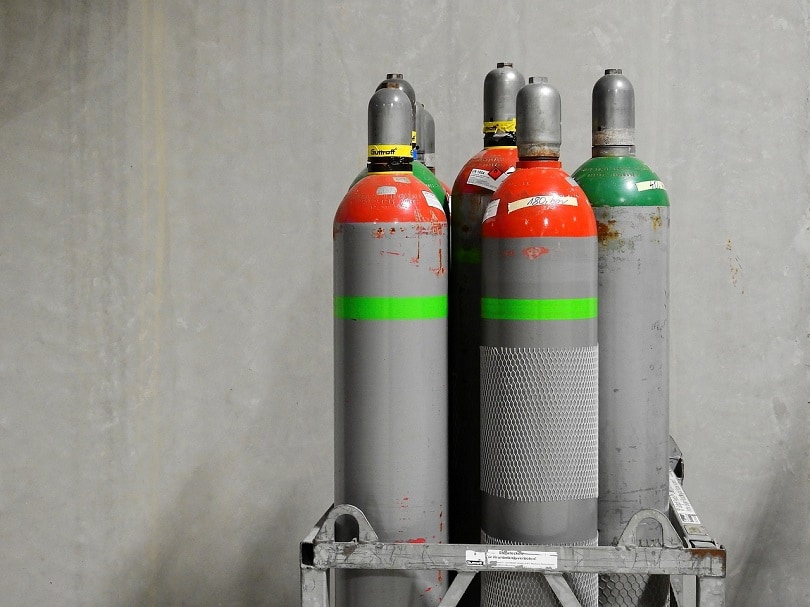
Credit: Bru-nO, Pixabay
Inert Gases (Noble Gases)
Under standard environmental conditions, noble gases are highly resistant to chemical changes. It implies that the shielding weld and arc become the all-time protection with noble gases.
Helium and argon are the most common noble gases. The ii gases are commonly used in TIG and MIG welding.
Most new welders ask, "Can I weld balmy steel using argon?"
Yes, you can.
Apart from carbon dioxide, argon is 1 of the virtually mutual shielding gases used in welding. Generally, Argon is used on its own, whether at 100% or combined with one or two other gases to let deeper penetration into the metal.
You lot're bodacious of a broader just not also deep weld penetration with argon shielding. It'due south excellent at maintaining the arc at a stable angle. Helium can grade a deeper weld and can produce a hotter burn compared to argon. Withal, it'south more costly equally compared to argon.
Noble gases form much less spatter when welding considering they have a higher resistance to chemical reaction than semi-inert or non-inert gases. Helium significantly lessens the weld'southward porosity.
Nonetheless, helium utilizes much more power than argon and needs more care as it may get sultry and lead to overheating and burnouts.
Many welders combine both helium and argon with other inexpensive gases to ensure the costs are downward. And because pure argon and helium are only recommended for non-ferrous metals such as copper and aluminum, mixing is too of import.
Selecting a Suitable Shielding Gas
Numerous MIG welding applications offer a variety of shielding gas options. You take to assess your welding objectives and applications to select the right one for your item application.
Welding gases play a crucial function in welding piece of work. They preclude atmospheric gases such as nitrogen, hydrogen, and oxygen from getting to the weld pool. These atmospheric gases tin cause issues with the finished weld quality once they get to the weld pool. Therefore, a shielding gas is required.
The question is, which shielding gas are you supposed to use? Argon, carbon dioxide, oxygen, and helium are the four most commonly used shielding gases. Each of them offers unparalleled advantages and disadvantages in every application.
When making your choice, take into account the following:
- The toll of the gas
- The finished weld characteristics
- Grooming and cleaning after welding
- The parent metal
- Your productivity objectives
The Price of the Gas
In any manufacturing procedure, the cost is a crucial consideration. Some gases cost more than than others. CO2 (carbon dioxide) is the almost affordable gas among the iv gases used in MIG welding.
You lot can use information technology in its pure class and, therefore, yous don't demand a secondary gas. It saves y'all more money.
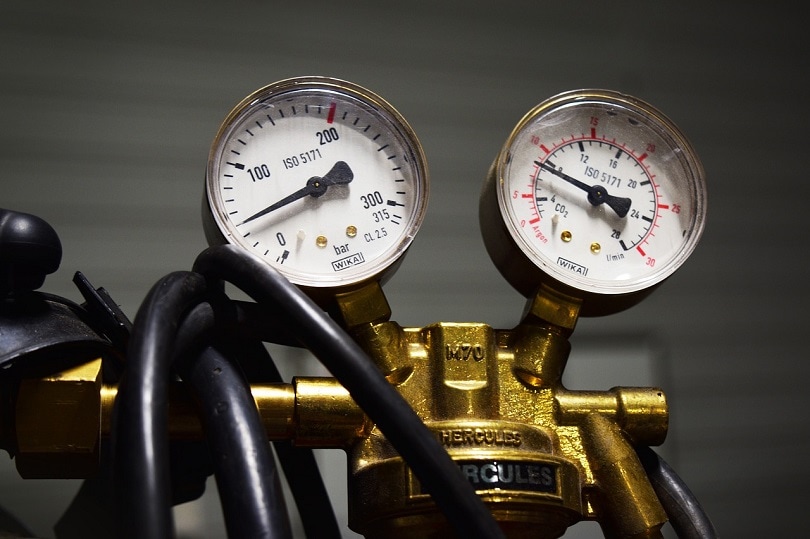
Credit: Mimzy, Pixabay
Characteristics of the Finished Weld
Several parts have to be finished finely. You can clean upward others afterward while others don't need any special finishing requirements. Argon or argon-carbon dioxide mixture is the best choice if you want less spatter, better welding action, or flatter bed profiles.
Argon is a element of group 0 and, therefore, it doesn't react with molten weld. Withal, information technology'south costly. Adding carbon dioxide tin can reduce costs and still offer agreeable weld quality.
Grooming and Cleaning After Welding
If yous're concerned with preps and cleaning up after welding, an argon and carbon dioxide mixture is the best pick. It offers excellent arc stability, puddle regulation, and lessened spatter as compared to pure carbon dioxide.
The Parent Cloth
Helium and carbon dioxide offering deep and broad welds and, therefore, are ideal for thick parent materials. Not-ferrous metals such as magnesium, aluminum, and titanium perform all-time with unadulterated argon.
Helium is an excellent gas with these metals and for stainless steel as well. Oxygen does well with balmy carbon, stainless steel, and depression alloy. Notwithstanding, information technology leads to corrosion. Therefore, don't use it with magnesium, copper, aluminum, or any other exotic metals.
Your Productivity Requirements
The mixture of argon and carbon dioxide works well in the spray transfer procedure, which enhances productivity. Another preferred mixture is argon and helium. In this mixture, speed is a factor. Information technology creates a hotter arc that spreads rapidly and increases productivity.
Gases Used In MIG Welding
Argon
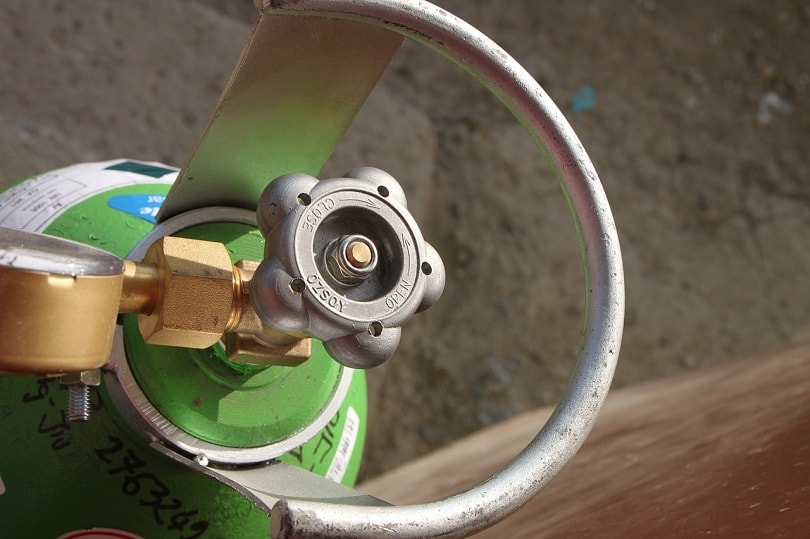
Credit: byrev, Pixabay
A mixture of between 75 to 95% argon and 5 to 25% carbon dioxide could exist the all-time pick for firms that stress more on weld quality. It'll offer a more suitable combination of puddle regulation, arc stability, and lessened spatter than pure carbon dioxide.
With this mixture, yous can use a spray transfer procedure that may generate loftier productivity rates and more visually attractive welds. Argon also creates a narrower penetration profile, that's helpful for barrel and fillet welds.
When welding a not-ferrous metallic such as titanium, aluminum, and magnesium, you lot take to utilise 100% argon.
Properties of Argon:
- It'south non suitable for steel.
- It'southward the best gas for non-ferrous metals.
CO2 (carbon dioxide)
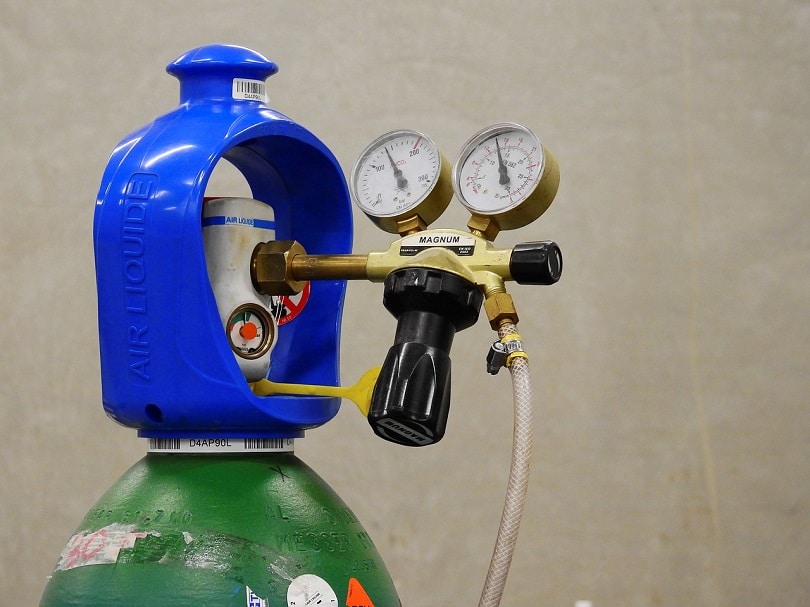
Credit: Bru-nO, Pixabay
In MIG welding, carbon dioxide is the nigh common reactive gas. Information technology's the only gas you can utilise in its pure class without calculation a noble gas. carbon dioxide is too the cheapest among the shielding gases, making it an appealing choice when fabric costs are the peak priority.
Pure carbon dioxide offers deep weld penetration, which is helpful when information technology comes to welding wide metals. Yet, information technology likewise generates a less steady arc and more spatters than when mixed with other gases. Also, it's restricted to only the short excursion procedure.
Properties of carbon dioxide:
- It penetrates deeper.
- It produces lots of spatter.
- It's cheap.
- You cannot use it with thin metal.
Oxygen

Credit: Mimzy, Pixabay
It's a reactive gas that's usually used in the ratios of 9% or less to enhance weld puddle fluidity, arc stability in mild carbon, penetration, stainless steel, and low alloy. However, it leads to corrosion of the weld metallic. Therefore, y'all shouldn't apply it with magnesium, aluminum, copper, or whatsoever other exotic metals.
You cannot utilize oxygen as a blank gas. However, you can mix it in amounts of one% to five% argon and carbon dioxide. It helps improve weld quality.
Oxygen and argon are mostly used for spray transfer on stainless steel to help generate a steady arc. However, the increased fluidity of the weld pool tin can make out-of-position welding an issue.
Properties of Oxygen:
- You cannot use information technology solitary as it causes corrosion.
- Run across also: Where to Go Welding Gas & How Much Should You Pay?
Helium
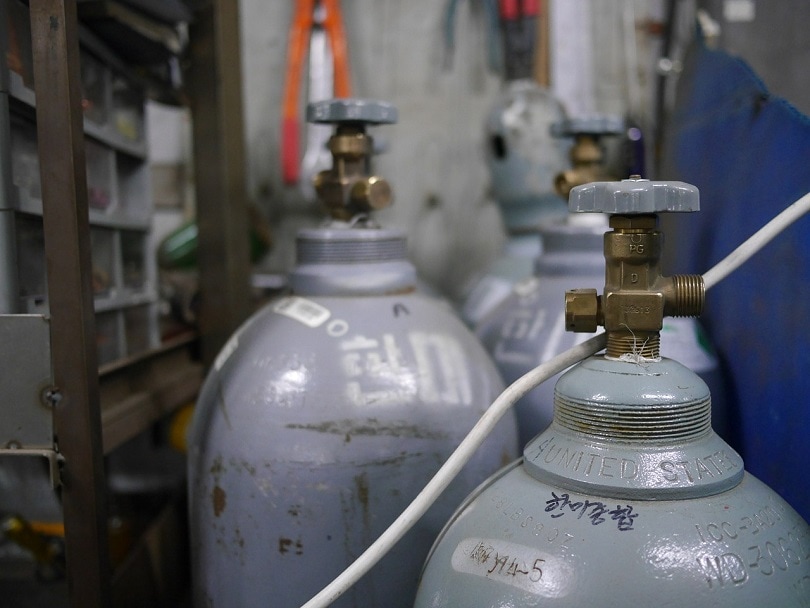
Credit: virusmon, Pixabay
Like to pure argon, helium is mostly used with non-ferrous metals and also with stainless steel. Since it generates a broad and deep penetration profile, helium does well with thick metals and is typically used in ratios of betwixt 25 and 75% helium to 75 and 25% argon.
By adjusting these ratios, the travel speed, dewdrop profile, and penetration are inverse. Helium generates a "hotter" arc that enables quicker travel speeds and higher productivity rates.
Withal, it's the costliest and needs a college charge per unit of menstruation as compared to argon. You have to calculate the productivity increment value versus the increased gas price. When information technology comes to welding stainless steel, helium is generally used in a tri-combination of carbon dioxide and argon.
Properties of Helium:
- It's non normally used
- It'south the best for not-ferrous metals.
- Information technology'south suitable for thick parent metal.
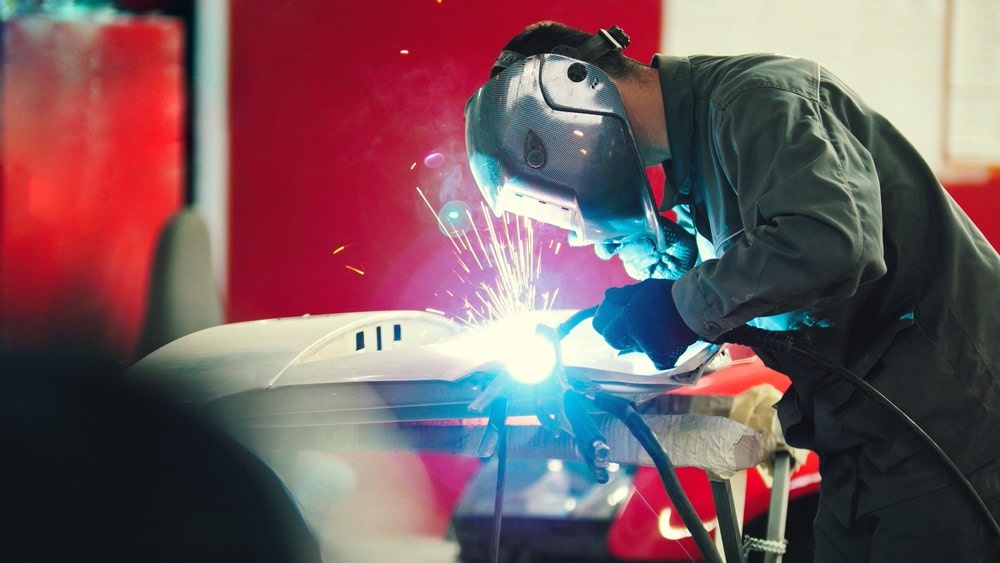
Epitome credit: Studio 72, Shutterstock
Reward of Argon-Carbon Dioxide Mixture And 100% Carbon Dioxide
These two gas mixtures provide users with different benefits and drawbacks. The ane y'all shall use relies on your specific welding purpose.
Argon-Carbon Dioxide Mixture for Shielding
If your shielding gas has a higher percentage of argon mixture, then you'll take improve quality projects.
A 75-25 blend lets you work fast and, therefore, your finished projects will have a much cleaner appearance. The mixture is preferred if y'all're working on frail projects with thinner welds or metals that lie on your structures' top surfaces.
Several people also increment the ratio of argon and choose the 85%-25% mixture as it offers them a sleeker bead end.
Even so, there are two issues with a high argon mixture. To begin with, it's costly. If you're an practiced welder, ensure that your costs don't exceed the toll you enquire for your services.
The other consequence is that a higher concentration of argon reduces the rate of penetration of the arc. For this reason, welders don't apply unadulterated argon gas for welding. Shielding gases that contain a noble gas, such as argon, aren't suitable for MIG welding mild steel because they by and large lead to an ugly, inconsistent weld seam.
100% Carbon Dioxide for Shielding
If y'all're concerned with the price and don't desire your welds to look their best, y'all can use carbon dioxide for MIG welding mild steel. Information technology'southward significantly inexpensive as compared to an argon mixture and is available at supply retailer stores.
carbon dioxide isn't a noble gas similar argon. However, it provides sufficient chemic protection that's normally used in MIG welding equally a shielding gas. The reaction with the arc generates a "hotter" feeling as compared to the C25 mixture.
It produces a deeper penetration in the connecting metals and creates a strong, larger bead. When used with pure carbon dioxide, the electrical arc isn't steady. It makes the arc crackle and pops more, forming spatter.
Information technology also forms a mild amount of smoke and fumes when welding. Higher spatter implies that more cleaning is needed after the job is done. You shouldn't utilise pure carbon dioxide if you're welding thinner metal gauges at low Amps. It's because the arc may blow holes in the frame.
Conclusion: How to Cull the All-time Gas for MIG Welding
If you're searching for the best gas to use for MIG welding that has broad application, the 25% carbon dioxide and 75% argon or anything similar to that such every bit an 80/xx mix, is possibly your best choice.
If you're on a upkeep and won't mind cleaning up a little additional spatter, carbon dioxide is inexpensive at splendid when it comes to experimentation and hobby welding. 100% argon is the fashion to go for MIG welding aluminum, or generally TIG welding.
With stainless steel, things get more costly when more than helium is mixed with argon and carbon dioxide or Oxygen. There, you also accept the option of selecting cheaper C2 with a 98/twenty mix.
E'er have into account the metals you desire to weld and ensure that y'all're getting the virtually out of your gas period. Don't forget that the key to a dependable bead design and avoiding overheating the metal is your preferred gas and your gas' flow rate.
For gas flow setting and experiment, contact the manufacturer to encounter what will work best for you lot and one that will be convenient.
Featured epitome credit: stafichukanatoly, Pixabay
- The All-time Gas To Apply for MIG Welding: What Are the Options?
- Inert Gases (Noble Gases)
- Selecting a Suitable Shielding Gas
- The Price of the Gas
- Characteristics of the Finished Weld
- Preparation and Cleaning After Welding
- The Parent Material
- Your Productivity Requirements
- Gases Used In MIG Welding
- Argon
- CO2 (carbon dioxide)
- Oxygen
- Helium
- Advantage of Argon-Carbon Dioxide Mixture And 100% Carbon Dioxide
- Argon-Carbon Dioxide Mixture for Shielding
- 100% Carbon Dioxide for Shielding
- Conclusion: How to Choose the Best Gas for MIG Welding
Cameron Dekker
Cameron grew upward in Allentown, Pennsylvania, a once-proud steel town on the Lehigh River, where he got a sense of taste of TIG welding in his loftier school shop form. He holds certificates for Certified WeldingEducator (CWE) and Certified Resistance Welding Technician (CRWT) from the American Welding Constitute. His interests include scuba diving, sculpture, and kayaking.
Source: https://waterwelders.com/best-gas-for-mig-welding/
0 Response to "Is 95 Amp Mig Welder Ok for Metal Art"
Post a Comment